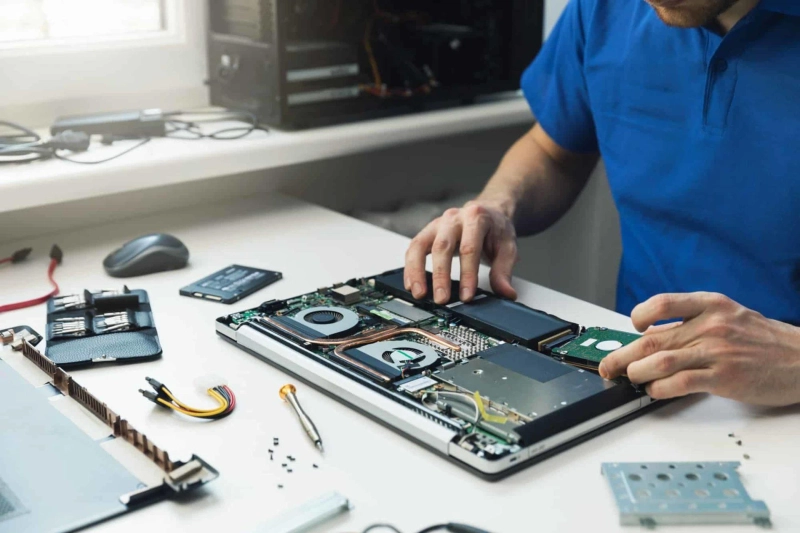Hardware failures in personal computers can be both perplexing and frustrating, but with a methodical approach, many issues can be diagnosed and repaired without the need for professional intervention.
This article explains the essential steps to troubleshoot and repair common hardware failures in your PC, leveraging both basic and advanced techniques. Alternatively, if you prefer professional assistance, Computer Repair Specialists can handle all these tasks for you, ensuring your PC runs smoothly without any hassle on your part.
Identifying Hardware Failures
Recognizing Symptoms
Hardware issues often present through distinct symptoms, which include:
- Frequent system crashes or spontaneous reboots.
- Blue Screen of Death (BSOD) displaying error codes.
- Degraded performance characterized by sluggish response times.
- Auditory indicators such as clicking or grinding noises.
- Display issues including a blank screen or no signal.
Preliminary Checks
Before diving into detailed diagnostics, it is prudent to perform the following initial checks:
- Reboot the System: A simple restart can sometimes resolve minor glitches.
- Verify Connections: Ensure that all cables and components are securely connected.
- Note Error Messages: Record any error messages or codes that appear, as these can provide valuable clues.
For those who prefer not to handle these steps themselves, Computer Repair Specialists can conduct these preliminary checks swiftly and accurately.
Diagnosing Common Hardware Failures
Power Supply Issues
Symptoms
- The computer fails to power on.
- Random shutdowns or reboots.
Troubleshooting Steps
- Check Power Connections: Confirm that the power cable is firmly connected to both the power supply unit (PSU) and the wall outlet.
- Test Alternate Outlets: Plug the PC into a different electrical outlet to rule out power source issues.
- Inspect the PSU: Look for visible signs of damage or a burnt smell. Utilize a PSU tester to measure the voltage outputs and ensure they are within the acceptable range.
Solution
Should the PSU be identified as faulty, replace it with a unit of equivalent or greater wattage, ensuring compatibility with your PC\'s components. Power supply replacements are a common task in computer repairs.
If you\'re uncomfortable with these steps, our team at Computer Repair Specialists can diagnose and replace a faulty PSU, ensuring a reliable power supply for your PC.
RAM (Memory) Failures
Symptoms
- Frequent crashes or BSOD occurrences.
- Noticeable slowdowns and performance degradation.
- Failure of the system to boot.
Troubleshooting Steps
- Run Memory Diagnostics: Utilize tools such as Windows Memory Diagnostic or MemTest86 to scan for errors.
- Reseat the RAM Modules: Power down the PC, remove the RAM sticks, and then securely reinsert them.
- Test RAM Modules Individually: If multiple RAM sticks are present, test each one in isolation to pinpoint the defective module.
Solution
Replace any malfunctioning RAM modules with new ones that are compatible with your motherboard and match the specifications of the existing modules. Memory replacements are a routine part of computer repairs that can significantly enhance performance.
Computer Repair Specialists can handle all aspects of RAM diagnostics and replacements, providing a seamless upgrade or repair process.
Hard Drive Failures
Symptoms
- System performance significantly slows down or freezes.
- Boot errors or failure to boot.
- Data corruption or inaccessibility of files.
Troubleshooting Steps
- Check for Disk Errors: Utilize CHKDSK, a built-in Windows utility, to scan and repair disk errors.
- Listen for Unusual Noises: Clicking or grinding sounds are indicative of mechanical failure within the hard drive.
- Use Diagnostic Software: Tools such as CrystalDiskInfo provide a detailed health status of your hard drive, including SMART data analysis.
Solution
If the hard drive is found to be failing, back up any accessible data immediately and replace the drive. Consider upgrading to a Solid State Drive (SSD) for enhanced performance and reliability.
For those needing professional help, Computer Repair Specialists offer expert data recovery and hard drive replacement services, ensuring your data is safe and your PC is running optimally.
Graphics Card Issues
Symptoms
- Screen artifacts, such as lines or distorted images.
- Display driver crashes.
- No signal to the monitor.
Troubleshooting Steps
- Update Drivers: Ensure that the graphics card drivers are up to date. Visit the manufacturer’s website for the latest versions.
- Check Physical Connections: Confirm that the graphics card is securely seated in its slot and that all power connectors are attached.
- Test the Card in Another System: If possible, test the graphics card in a different computer to determine if the issue persists.
Solution
Should the graphics card be defective, replace it with a compatible model. Ensure that the new card meets your system’s power and space requirements. Swapping out graphics cards is a frequent task in computer repairs, often necessary for maintaining or upgrading graphical performance.
For those preferring professional intervention, Computer Repair Specialists can efficiently diagnose and replace faulty graphics cards, ensuring your visual performance is top-notch.
Conclusion
Troubleshooting and repairing hardware failures require a methodical approach and a combination of both basic and advanced diagnostic techniques. By understanding the symptoms and following structured troubleshooting steps, many common hardware issues can be identified and resolved effectively. For more complex problems or when in doubt, seeking professional assistance from Computer Repair Specialists is recommended to avoid causing further damage to your system. Regular maintenance, such as keeping components clean and ensuring up-to-date drivers, can also help prevent hardware failures and prolong the life of your PC.


